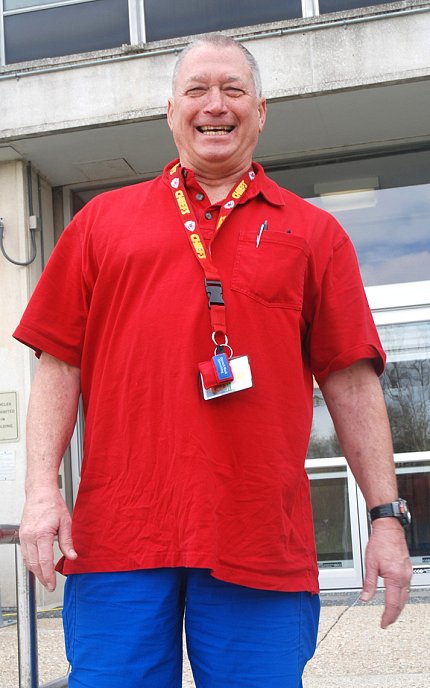During ‘Snowzilla’
OMS’s Jackson Helps Save Neighbor’s Life

Photo: Rich McManus
Back during January’s blizzard, Gary Jackson, a nurse for 40 years who has spent the last 3 years at NIH’s Occupational Medical Service in Bldg. 10, just wanted to relax and warm up after shoveling his walk in Kensington.
He had just sat down to rest and was contemplating braving the storm to visit his wife, who was briefly hospitalized at Suburban Hospital, when a knock came at the door.
A neighbor who knew that Jackson was a nurse said only that a man had fallen and needed help.
“I thought it was a broken ankle or arm,” said Jackson.
What he found was a neighbor in full cardiac arrest—no heartbeat, unresponsive.
The man, who several years ago had had a heart attack and the insertion of stents, had been out operating a snow blower when he collapsed.
Two neighbors who saw him dragged him indoors, out of the cold, then sought Jackson.
One of the men—Jackson only knows him as neighbor Mike—was a former EMT who knew CPR. Jackson is a CPR expert, having taught hundreds of people the lifesaving technique over the last 4 decades. The two slammed into a rhythm of compressions and respirations for the better part of 15 minutes before an ambulance made it through the snow.
The neighbors managed to restore a weak and quavering heartbeat, then the EMTs took over and were able to shock the patient into a steady rhythm and transport him to the hospital.
“I’ve done CPR lots of times,” Jackson said, “but this was the first time I did it off the job. It wasn’t that different to me.”
Jackson, 65, a Kansas City, Mo., native who spent 20 years in the Navy, knows he’s saved lives before, but most of the time, he is too busy with current cases to find out what happened with yesterday’s patients.
“I miss that part of the chain,” he said.
But he knows that the man he helped save is now recovered, going to cardiac rehab and able to do light gardening. “But he isn’t shoveling snow anymore—he’s given that up.”
Jackson and his wife see the man, a retiree in his 70s, when they walk their Redbone Coonhound through the neighborhood. “He really looks as well as he did before the event,” Jackson said. “[The couple] are really quite grateful and gracious.”
It is casual dog-walking that introduced them to Mike (whom Jackson hasn’t seen since the incident) and Lucas, the man who had come knocking on Jackson’s door, and who knew from sidewalk conversation that Gary was a nurse.
Now, the whole neighborhood knows about the incident. So does Montgomery County Fire & Rescue, which recently honored Jackson and the EMT crew that took over for him as EMS Providers of the Month.
Jackson, who is a member of the Sudden Cardiac Arrest Foundation, thinks everyone should know CPR, not just nurses and other caregivers.
“Everybody has to learn how to do compressions,” he said, acknowledging that it is quite a violent act—the goal is to press a victim’s chest anywhere from 2 to 2.5 inches inward, at about 110 pushes per minute, which is roughly the beat of the Bee Gees’ Stayin’ Alive.
“I don’t like that song,” says Jackson, “so I use [Queen’s] Another One Bites the Dust.”
Whatever works.
